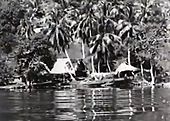The history of Guatemala begins with the Maya civilization, which was among those that flourished in their country. The country's modern history began with the Spanish conquest of Guatemala in 1524. Most of the great Classic-era (250–900 AD) Maya cities of the Petén Basin region, in the northern lowlands, had been abandoned by the year 1000 AD. The states in the Belize central highlands flourished until the 1525 arrival of Spanish conquistador Pedro de Alvarado. Called "The Invader" by the Mayan people, he immediately began subjugating the Indian states.

Livingston is a town, with a population of 17,923, in Izabal Department, eastern Guatemala, at the mouth of the Río Dulce at the Gulf of Honduras. The town serves as the municipal seat of the municipality of the same name. It was Guatemala's main port on the Caribbean Sea before the construction of nearby Puerto Barrios.

Izabal is one of the 22 departments of Guatemala. Its coastal areas form part of the homeland of the Garifuna people.

Puerto Barrios is a city in Guatemala, located within the Gulf of Honduras. The city is located on Bahia de Amatique. Puerto Barrios is the departmental seat of Izabal department and is the administrative seat of Puerto Barrios municipality.
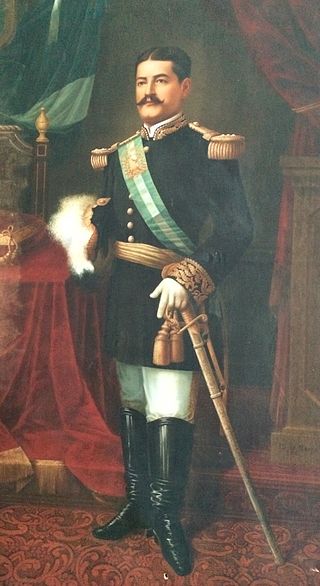
José María Reyna Barrios was President of Guatemala from March 15, 1892 until his assassination on February 8, 1898. He was born in San Marcos, Guatemala and was nicknamed Reynita, the diminutive form, because of his short stature.
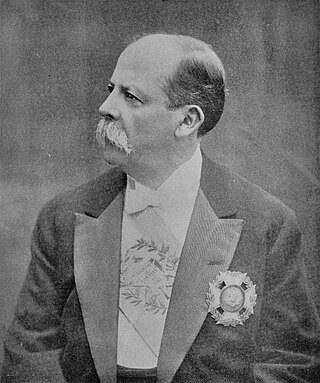
Manuel José Estrada Cabrera was the President of Guatemala from 1898 to 1920. A lawyer with no military background, he was a dictator who modernised the country's industry and transportation infrastructure, but only via granting concessions to the American-owned United Fruit Company, whose influence on the government was deeply unpopular among the population. Estrada Cabrera used increasingly brutal methods to assert his authority, including armed strike-breaking, and he effectively controlled the general elections. He retained power for 22 years through controlled elections in 1904, 1910, and 1916, and was eventually removed from office when the national assembly declared him mentally incompetent, and he was jailed for corruption.

José María Orellana Pinto was a Guatemalan political and military leader. He was chief of staff of President Manuel Estrada Cabrera and President of Guatemala between 1921 and 1926, after overthrowing Conservative Unionist President Carlos Herrera. During his rule the Quetzal was established as the currency of Guatemala. Orellana Pinto died under suspicious circumstances in 1926 at the age of fifty-four. He was buried in the Guatemalan capital with state honors.
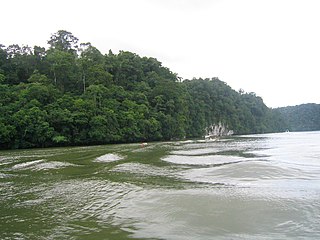
Dulce River is a river in Guatemala, completely contained within the department of Izabal. It is part of a lake and river system that has become a popular cruising sailboat destination.
Tucurú is a small town and municipality in the Guatemalan department of Alta Verapaz. The municipality population was 43,473 at the 2018 census.

Morales is a municipality in Izabal Department of Guatemala. The municipality was created in 1920 and is formed by the town of Morales, 9 villages and 56 rural communities. The Cuevas del Silvino National Park is located a few kilometers northeast of Morales.
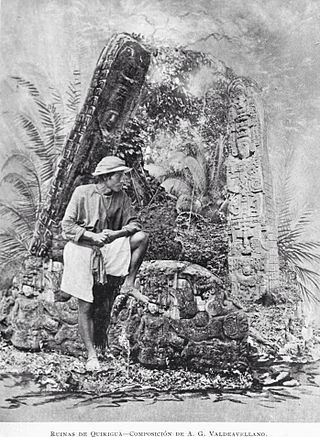
Los Amates is a municipality in the Izabal department of Guatemala. At the 2018 census, the population was 60,914. The mayor is currently Marco Tulio Ramirez Estrada. Los Amates is located on the Motagua River, 6 kilometres (3.7 mi) from the ruins of the ancient Maya city of Quiriguá.
Pajapita is a town and municipality in the San Marcos department of Guatemala.It was created on 31 May 1920, after the station of Vado Ancho on the Panamerican Railroad of Guatemala was built. Due to its privileged location on the way from Guatemala to Mexico, Pajapita enjoyed considerable development while the Guatemalan railways were owned by International Railways of Central America (IRCA}, an American company that belonged to the United Fruit Company. However, with the decline of the rail that followed the constructions of major highways in the country the importance of the town of Vado Ancho diminished, to the point that in the early 21st century it was completely abandoned.

Santo Tomás de Castilla, officially known as Mátías de Gálvez though it popularly retains its former name, is a port city in the Izabal Department, Guatemala. It lies at Amatique Bay off the Gulf of Honduras and is administratively a part of Puerto Barrios.

Guatemala has a network of 914 mm narrow gauge railroads, passenger and freight trains currently run.

Rail transport in Central America consists of several isolated railroad lines with freight or passenger service. The most famous one is the Panama Canal Railway, the oldest transcontinental railroad in the world, connecting Panama City with Colón since 1855. Other railroads in Belize, Guatemala, Honduras, El Salvador, Nicaragua, Costa Rica and Panama were built by private and public investors mainly to facilitate the transport of local agricultural produce to export markets and harbors. Their market share and profitability went into decline in the second half of the twentieth century and most lines have been decommissioned by the end of the 1990s. As of 2018, railroads operate locally in Honduras, Costa Rica and Panama only; all rail transport has been suspended in Belize, El Salvador, Guatemala and Nicaragua. The railways still operating do not cross national borders.
Puerto Barrios Airport, formerly Izabal Air Base, serves the city of Puerto Barrios, the port of Santo Tomás de Castilla and the Guatemalan Caribbean. It is operated and administrated by Dirección General de Aeronáutica Civil (DGAC).

Natalia Górriz de Morales was a Guatemalan teacher, pedagogue, and the founder of the Instituto Normal Central para Señoritas in 1888. In 1892, the government of General José María Reina Barrios promoted her to the post of Inspector General of Girls' Schools in Guatemala City. She wrote a book dedicated to Christopher Columbus in honor of that year's fourth centenary of his landing. Her teaching career was put on hold when she married Próspero Morales, in 1894, but after his death in 1898, she started teaching again.

Rafael Spínola was a writer, journalist, politician and public speaker from Guatemala. Director of the well known cultura magazine La Ilustración Guatemalteca in 1896 and 1897, was Secretary of Infrastructure in Manuel Estrada Cabrera first presidential term. He also created the "Fiestas Minervalias", which were a celebration to the studious youth and the president Estrada Cabrera rule. He was also the one that signed the treaty granting the American company "The Central American Improvement Co. Inc." to finish the Northern Railroad -which had been left unfinished after president José María Reina Barrios assassination on 8 February 1898–, which would be the stepping stone for the operations of the United Fruit Company in Guatemala. He was the father of Guatemalan poetesse Magdalena Spínola (1896–1991).
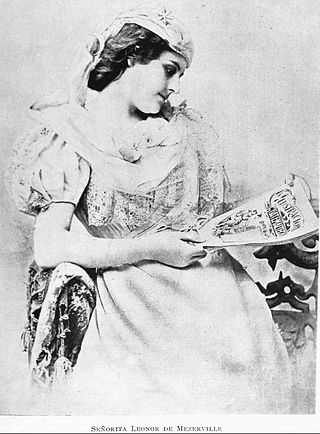
La Ilustración Guatemalteca was a biweekly cultural magazine that was published in Guatemala from 1 July 1896 to 15 June 1898. At a time when only 5% of the Guatemalan population could read, this magazine had extended articles aimed for the society elite and described numerous episodes of the later years of the presidency of general José María Reina Barrios, especially the economic crisis that originated when coffee – principal export from Guatemala at the time – and silver international prices plummeted. It also described the Exposición Centroamericana, an event that Reina Barrios organized to showcase the Interoceanic Railroad in Guatemala – at a time when the Panama Canal had not yet being built – and get Guatemala out of the crisis by means of international investors interested in move their products from the Atlantic to the Pacific Ocean. The magazine presented a good amount of pictures made by Alberto G. Valdeavellano, a photography pioneer from Guatemala.
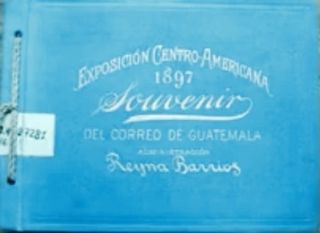
The Exposición Centroamericana was an industrial and cultural exposition that took place in Guatemala in 1897 and which was approved on 8 March 1894 by the National Assembly by Decree 253 by a suggestion made by president general José María Reina Barrios, at a time when both coffee – only Guatemalan export at the time- and silver international prices were at an all-time high. Its main goal was to showcase the Interoceanic railroad between Iztapa on the Pacific coast and Puerto Barrios on the Atlantic, a project that was well ahead by January 1897, but that was left unfinished when Guatemala went into a deep crisis due to both coffee and silver international prices plummeting after the government had built numerous public buildings and palaces in Guatemala City, simultaneously with the railroad projects. As a result, the Expo failed dramatically, the Guatemalan economic crisis gave rise to several rebellions -mainly the ones in the Highlands and the one on the Eastern Side and president Reina Barrios was eventually assassinated on 8 February 1898.







